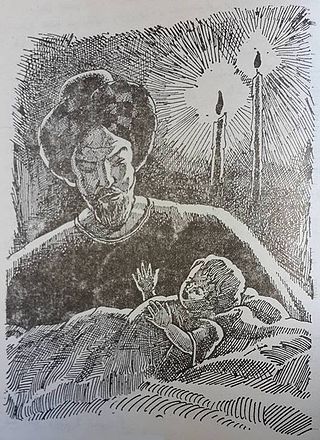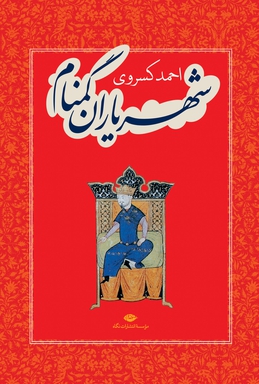
Asad ad-Dīn Shīrkūh bin Shādhī, also known as Shirkuh, or Şêrko was a military commander in service of the Zengid dynasty, and uncle of Saladin. His military and diplomatic efforts in Egypt were a key factor in establishing the Ayyubid dynasty in that country.

Demetrius I, from the Bagrationi dynasty, was King (mepe) of Georgia from 1125 to 1156. He is also known as a poet. He was King of Georgian kingdom two times, first in 1125 to 1154 and second in 1155 before his death in 1156. King Demetrius I struggled tirelessly to protect the inheritance he had received from his father he guarded Georgia’s borders and fought to enlarge its frontiers. Many regions, including Hereti, Somkhiti, Tashiri, Javakheti, Artaani and Tao were repopulated during King Demetrius ’s reign.

George III, of the Bagrationi dynasty, was the 8th King (mepe) of Georgia from 1156 to 1184. He became king when his father, Demetrius I, died in 1156, which was preceded by his brother's revolt against their father in 1154. His reign was part of what would be called the Georgian Golden Age – a historical period in the High Middle Ages, during which the Kingdom of Georgia reached the peak of its military power and development. George was the father of Queen Tamar the Great.
Ibn Shaddad can refer to:

The Shaddadids were a Kurdish Sunni Muslim dynasty. who ruled in various parts of Armenia and Arran from 951 to 1199 AD. They were established in Dvin. Through their long tenure in Armenia, they often intermarried with the Bagratuni royal family of Armenia.

Shams al-Din Ildeniz, Eldigüz or Shamseddin Eldeniz was an atabeg of the Seljuq empire and founder of the dynasty of Eldiguzids, atabegs of Azerbaijan, which held sway over Armenia, Iranian Azerbaijan, and most of northwestern Persia from the second half of the 12th century to the early decades of the 13th.

The Ildegizids, Eldiguzids or Ildenizids, also known as Atabegs of Azerbaijan were an Atabegate of the Seljuk Empire, and a Sunni Muslim Turkic dynasty, which controlled most of northwestern Persia, eastern Transcaucasia, including Arran, most of Azerbaijan, and Djibal. At their maximum extent, the territory under their control, roughly corresponds to most of north-western Iran, most of the regions of modern Azerbaijan and smaller portions in modern Armenia, Turkey and Iraq. Down to the death in war 1194 of Toghril b. Arslan, last of the Great Seljuq rulers of Iraq and Persia, the Ildenizids ruled as theoretical subordinates of the Sultans, acknowledging this dependence on their coins almost down to the end of the Seljuqs. Thereafter, they were in effect an independent dynasty, until the westward expansion of the Mongols and the Khwarazm-Shahs weakened and then brought the line to its close.

al-Malik al-Afdal Najm al-Dīn Ayyūb ibn Shādhi ibn Marwān, or simply Najmadin, was a Kurdish soldier and politician from Dvin, and the father of Saladin. He is the eponymous ancestor of the Ayyubid dynasty.

The Kingdom of Georgia, also known as the Georgian Empire, was a medieval Eurasian monarchy that was founded in c. 1008 AD. It reached its Golden Age of political and economic strength during the reign of King David IV and Queen Tamar the Great from the 11th to 13th centuries. Georgia became one of the pre-eminent nations of the Christian East and its pan-Caucasian empire and network of tributaries stretching from Eastern Europe to Anatolia and northern frontiers of Iran, while also maintaining religious possessions abroad, such as the Monastery of the Cross in Jerusalem and the Monastery of Iviron in Greece. It was the principal historical precursor of present-day Georgia.
The Saltukids or Saltuqids were a dynasty ruling one of the Anatolian beyliks founded after the Battle of Manzikert (1071) and centered on Erzurum. The Saltukids ruled between 1071 and 1202. The beylik was founded by Emir Saltuk, one of the Turkmen commanders of the Great Seljuk Alp Arslan. The beylik fought frequently against the Georgian Kingdom for hegemony of the Kars region. The center of the beylik, Erzurum, was briefly re-occupied by the Byzantine Empire between 1077 and 1079, and was besieged by the Georgian King Giorgi III in 1184. It comprised the entirety of present-day Erzurum and Bayburt provinces, lands east of Erzincan, most of Kars, and lands north of Ağrı and Muş provinces during its height.

Abu'l-Aswar or Abu'l-Asvar Shavur ibn Fadl ibn Muhammad ibn Shaddad was a member of the Shaddadid dynasty. Between 1049 and 1067 he was the eighth Shaddadid ruler of Arran from Ganja. Prior to that, he ruled the city of Dvin from 1022 as an autonomous lord. A capable warrior, and a wise and cunning ruler, Abu'l-Aswar was engaged in several conflicts with most of his neighbours. During his rule over Dvin, he was mostly involved in the affairs of the Armenian principalities. He collaborated with the Byzantine Empire in its conquest of the last remnants of Bagratid Armenia in 1045, but when the Byzantines later turned on him, he survived three successive offensives that sought to take Ganja. In 1049, a revolt in Ganja overthrew his infant great-great-nephew, Anushirvan. The rebels invited him to take up the family's emirate, and he moved from Dvin to Ganja. Under his rule, the Shaddadid dynasty reached its zenith. He undertook successful campaigns into Georgia and Shirvan, although the limits of Shaddadid power were exposed by his failure to take over the Emirate of Tiflis and by devastating raids by the Alans. At the same time, his reign witnessed the rapid rise of the Seljuk Empire and the extension of its control over the Transcaucasian principalities. Abu'l-Aswar became a Seljuk vassal in 1054/5. Although he gained control over the former Armenian capital of Ani through Seljuk patronage in 1065, this association also paved the way for the dynasty's decline after his death in November 1067.

Bahāʾ al-Dīn Abū al-Maḥāsin Yūsuf ibn Rāfiʿ ibn Tamīm was a 12th-century Kurdish jurist, scholar and historian notable for writing a biography of Saladin whom he knew well.

The Georgian–Seljuk wars, also known as Georgian Crusade, is a long series of battles and military clashes that took place from c. 1048 until 1213, between the Kingdom of Georgia and the different Seljuqid states that occupied most of Transcaucasia. The conflict is preceded by deadly raids in the Caucasus by the Turks in the 11th century, known in Georgian historiography as the Great Turkish Invasion.
Saltuk II was a bey of Saltukids in the 12th century.
Fadl ibn Shavur ibn Manuchihr was Shaddadid emir of Ani from c. 1125 to 1130. Fadl was the son of deposed emir Abu'l-Aswar Shavur. Fadl retook Ani from the Georgians, but promised to observe the rights of its Christian population. Fadl extended his rule to Dvin and Ganja, but failed to maintain these cities. He was murdered by his courtiers following the fall of Dvin to the Turkish emir Qurti c. 1130. His brothers, Mahmud ibn Shavur and Khushchikr, ruled briefly in quick succession until the emirate was taken over by Fadl's nephew, Fakr al-Din Shaddad b. Mahmud.
Fadl V ibn Mahmud was a Shaddadid emir of Ani from 1155 to 1161.
Shahanshah ibn Mahmud was the Kurdish Shaddadid emir of Ani from 1164 to 1174.
Sultan ibn Mahmud was the last known Shaddadid emir of Ani reigning in parts of the dynasty's possessions from at least 1174 to c. 1199. He is known exclusively from the epigraphic data.

The Forgotten Kings is a Chronicle account by Ahmad Kasravi. it is wrote since late 1928 to 1929, which includes documentary research on several At that time unknown and anonymous post-Islamic to pre-Seljuk Empire Iranian dynasties.
The High Middle Ages, or Classic Feudalism Period in what constitutes the present-day Republic of Azerbaijan, lasted from around the 11th century to the 15th century AD. The High Middle Ages were preceded by the Early Middle Ages and were followed by the Late Middle Ages, which ended around the 15thcentury AD. Key historical trends of the High Middle Ages include the incorporation of the territories that constitute present-day Azerbaijan into the Seljuk Empire, the establishment of the Eldiguzids, the Mongol invasions and the rule of the Ilkhanate, the invasions of Timur and the establishment of the Turkoman Kara Koyunlu and Aq Qoyunlu tribal confederations.











